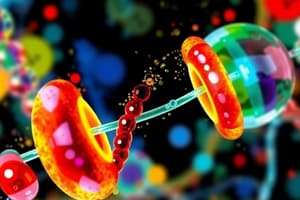Podcast
Questions and Answers
What is the primary function of ATP in cellular metabolism?
What is the primary function of ATP in cellular metabolism?
- To donate phosphoryl, pyrophosphoryl, and adenylyl groups
- To couple group transfer reactions to unfavorable reactions (correct)
- To synthesize ADP and Pi
- To harness the energy of hydrolysis
Why must ATP concentration be held high?
Why must ATP concentration be held high?
- To maintain the equilibrium concentration
- To maintain its high group transfer potential (correct)
- To prevent energy-yielding reactions
- To inhibit catabolic reactions
What is the equation for ΔGp in ATP hydrolysis?
What is the equation for ΔGp in ATP hydrolysis?
- ΔGp = ΔG´° - RT ln ([ADP][Pi] / [ATP])
- ΔGp = ΔG´° × RT ln ([ADP][Pi] / [ATP])
- ΔGp = ΔG´° + RT ln ([ADP][Pi] / [ATP]) (correct)
- ΔGp = ΔG´° / RT ln ([ADP][Pi] / [ATP])
What type of reaction is phosphoryl group transfer?
What type of reaction is phosphoryl group transfer?
What is the energy currency of the cell?
What is the energy currency of the cell?
Why is ATP hydrolysis favorable in the cell?
Why is ATP hydrolysis favorable in the cell?
What is the consequence of a spontaneous reaction in cellular metabolism?
What is the consequence of a spontaneous reaction in cellular metabolism?
What is the purpose of energy coupling in cellular metabolism?
What is the purpose of energy coupling in cellular metabolism?
What is the result of phosphoryl group transfer?
What is the result of phosphoryl group transfer?
What is the significance of the phosphate group in cellular metabolism?
What is the significance of the phosphate group in cellular metabolism?
What is the role of ATP in cellular metabolism?
What is the role of ATP in cellular metabolism?
What is the definition of phosphorylation potential?
What is the definition of phosphorylation potential?
What is the purpose of ATP hydrolysis in cellular metabolism?
What is the purpose of ATP hydrolysis in cellular metabolism?
What is the result of converting the concentration from µM to M?
What is the result of converting the concentration from µM to M?
What is the role of ATP in cellular metabolism?
What is the role of ATP in cellular metabolism?
During ATP hydrolysis, what happens to the phosphate group?
During ATP hydrolysis, what happens to the phosphate group?
What is the standard free energy of hydrolysis of ATP?
What is the standard free energy of hydrolysis of ATP?
What is the result of ATP hydrolysis in terms of pH?
What is the result of ATP hydrolysis in terms of pH?
What is the role of Pi in ATP hydrolysis?
What is the role of Pi in ATP hydrolysis?
What is the result of ATP hydrolysis in terms of solvation?
What is the result of ATP hydrolysis in terms of solvation?
Why does the actual free energy of hydrolysis of ATP under intracellular conditions differ from the standard free energy change?
Why does the actual free energy of hydrolysis of ATP under intracellular conditions differ from the standard free energy change?
What connects catabolism and anabolism?
What connects catabolism and anabolism?
Flashcards are hidden until you start studying
Study Notes
ATP and Phosphoryl Group Transfers
- ATP (Adenosine Triphosphate) is the major energy currency of the cell, produced in exergonic reactions and consumed in endergonic reactions via hydrolysis.
- ATP connects catabolism and anabolism.
- ATP has three components: adenine, ribose, and triphosphate groups.
ATP Hydrolysis
- ATP hydrolysis involves charge separation, which relieves electrostatic repulsion.
- Pi is stabilized by formation of a resonance hybrid.
- ADP2- immediately ionizes at pH 7, releasing a proton into the medium, lowering pH.
- Greater solvation of products Pi and ADP relative to ATP.
The Phosphorylation Potential, ∆GP
- The standard free energy of hydrolysis of ATP is -30.5 kJ/mol.
- The actual free energy of hydrolysis of ATP in the cell (ΔGp) differs from the standard free energy change in standard conditions (ΔG´o).
- ΔGp can be calculated using the equation: ΔGp = ΔG´° + RT ln ([ADP][Pi] / [ATP]).
ATP Donates Phosphoryl, Pyrophosphoryl, and Adenylyl Groups
- Each of the three phosphates of ATP is susceptible to nucleophilic attack.
- ATP drives unfavorable reactions not by harnessing the energy of hydrolysis but through the coupling of group transfer (phosphoryl, pyrophosphoryl, or adenylyl) to a substrate or enzyme.
Phosphoryl Group Transfer
- Phosphoryl group transfer is generally a two-step reaction.
- Phosphoryl group transfer is catalyzed by ATP-dependent enzymes, such as ATP-dependent glutamine synthetase.
Free Energy Changes Are Additive
- A favorable reaction (ΔG1 < 0) can drive an unfavorable reaction (ΔG2 > 0) when ΔG1 + ΔG2 < 0.
- This principle has important consequences in cellular metabolism, such as energy coupling.
Energy Coupling
- Energy coupling allows the energy from one reaction to drive another reaction.
- Example: the synthesis of glucose 6-phosphate, where the energy from ATP hydrolysis drives the reaction.
Studying That Suits You
Use AI to generate personalized quizzes and flashcards to suit your learning preferences.




